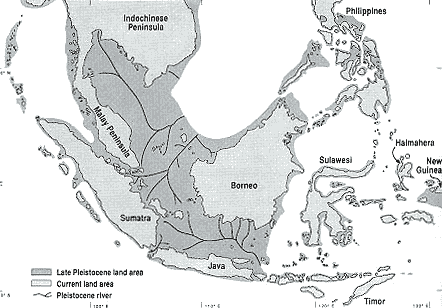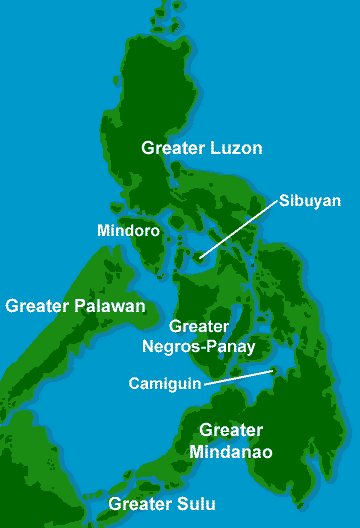Ice-Age History
This site is under redevelopment. Its content is from 1998, but we will be updating it in the near future.
The number of islands strewn across Southeast Asia—the region extending from the eastern edge of India to the western and northern edges of Australia and New Guinea—is astonishing. In the Philippines alone there are more than 7,000 islands, and Indonesia claims more than 12,000. One might believe, given the difficulty of movement between islands, that virtually every island would have a large number of unique species, especially among the small rodents and frogs and those plants whose seeds cannot tolerate sea-water.
Although this might seem to be a good prediction, it would nevertheless be wrong. The community of mammals in the maturelowland rain forest of northern Samar, for example, barely differs from that found in the same habitat on Basilan Island, 700 kilometers away. But on Borneo, only 340 kilometers away, identical habitats are radically different, sharing only 10 percent of the mammal species on Basilan. Even more remarkable, if we compare the mammals at the northern tip of Samar with those at the southern tip of Luzon—a distance of only about 25 kilometers—we find that 80 percent of the species are different. Similar discrepancies in faunas are evident between Luzon and the adjacent island of Mindoro, and between Bohol and neighboring Negros. And Sibuyan has its own remarkable set of unique species, as does the even smaller island of Camiguin (265 square kilometers, with at least two unique small mammals and a frog), which lies only eight kilometers from the coast of Mindanao.
On the other hand, equally unexpected patterns emerge showing great similarity between faunas. The fauna on Bohol is almost identical to that on Basilan, Mindanao, Leyte, and Samar, but not to that of nearby Negros; Masbate's fauna is far more similar to Panay's than to Luzon's, and the fauna of Palawan is more similar to Borneo's than it is to that of any other island in the Philippines. It would seem that the surface of the modern sea is hiding some underlying patterns.
The explanation for these patterns of similarity and dissimilarity may be found in an event—actually, a repeated series of events—that is familiar to those of us who live in North America and Europe. Fifteen- to twenty- thousand years ago, the regions now occupied by Chicago, St. Paul, Toronto, and many other North American cities, and by London, Copenhagen, and Moscow in Europe, were covered by sheets of ice more than a kilometer thick. These huge continental glaciers form about every 140,000 years, gradually growing and melting as the result of subtle shifts in the orbit of the earth around the sun. We now know that glaciers appeared at least 21 different times over the past several million years. This period of alternating glacial growth and melting is generally known as the Ice Age, or, more technically, as the Pleistocene Epoch.
The glaciers formed after water evaporating from the oceans was deposited on land as snow. In years when more snow fell in winter than could melt in summer, the glaciers grew. As the snow piled higher, the lower layers were compacted into ice by the weight from above. The existence of that ice—enough to cover nearly all of the northern half of North America and large parts of northern Europe and Asia, as well as some other regions—had a huge impact on the oceans, since water that stayed on the continents in the form of ice and snow was equaled by a drop in sea level. When the ice sheets were at their peak in the most recent phase of glacial growth (15,000 to 20,000 years ago), sea level was 120 meters (400 feet) lower than it is today.
In Southeast Asia, where some seas are rather shallow—often less than 80 meters deep—the impact of this change in sea level was enormous. Borneo, Java,and Sumatra were merged with the Asian continent in a great peninsula, much of it a broad, fertile lowland plain. Huge rivers flowed across this plain, leaving behind channels so deep and prominent that they can still be seen on the floor of the South China and Java seas, up to 80 meters below the current sea level. Freshwater fish found in streams in northern Java are most closely related to those in streams on southern Borneo, evidence of the freshwater rivers that once flowed across what is now the Java Sea. Around the edge of that giant Asian peninsula, water depths were (and are still) much greater—hundreds to thousands of meters—and so these areas remained permanently as sea. Some islands merged to form larger but still isolated land masses, while other islands grew somewhat but remained minimally affected.
The reasons for the odd patterns of distribution and diversity in the region now become clear. Land mammal faunas in northern Samar and Basilan are so similar because the animals were able towalk on dry land from one of these sites to the other. To go from northern Samar to the adjacent tip of Luzon, however, would have required that they cross a sea channel about ten kilometers wide. Mammals, frogs, and plants are able to spread across places with continuous habitat, even when thousands of kilometers are involved, but have great difficulty crossing even ten kilometers of sea water. The repercussions of this land distribution on biological diversity in Southeast Asia, the "land of islands," were enormous.
During the recent Ice Age, sea level dropped to about 120 meters below the present level, exposing huge areas as dry land, but the Philippines remained isolated by deep channels. The former riverbeds are still visible on the shallow sea-floor between Boneo and Java, Samatra, and the Malay Peninsula. |




